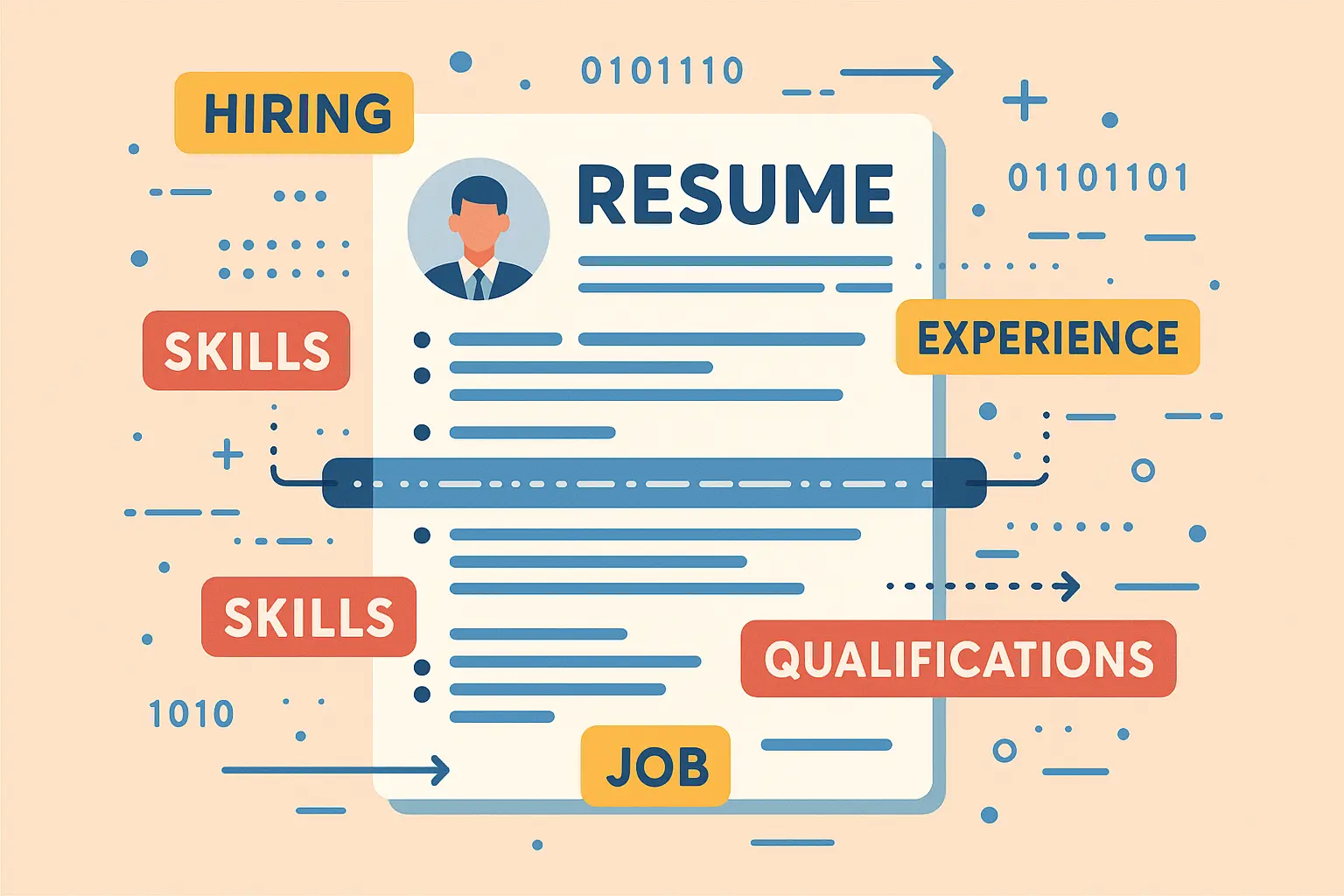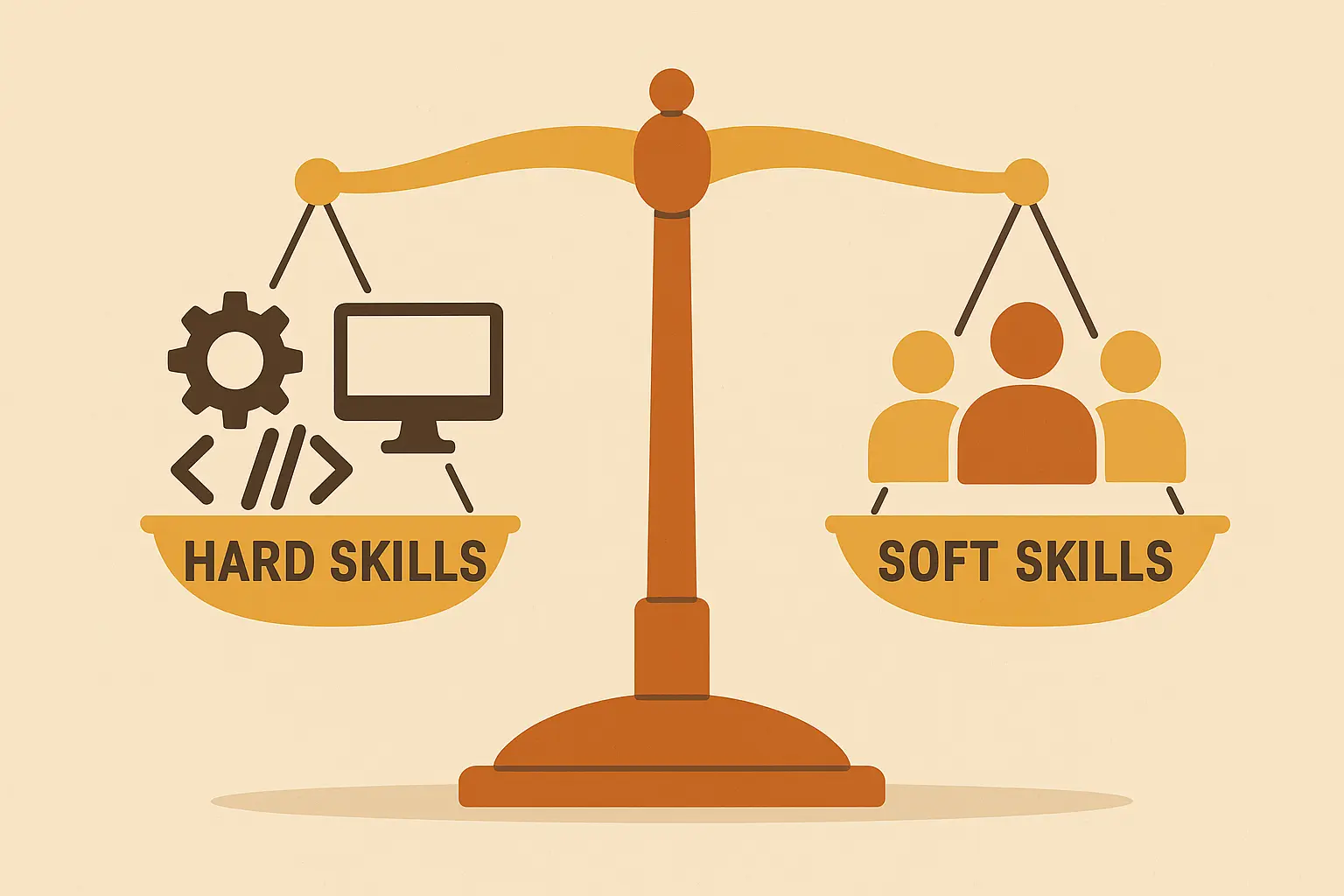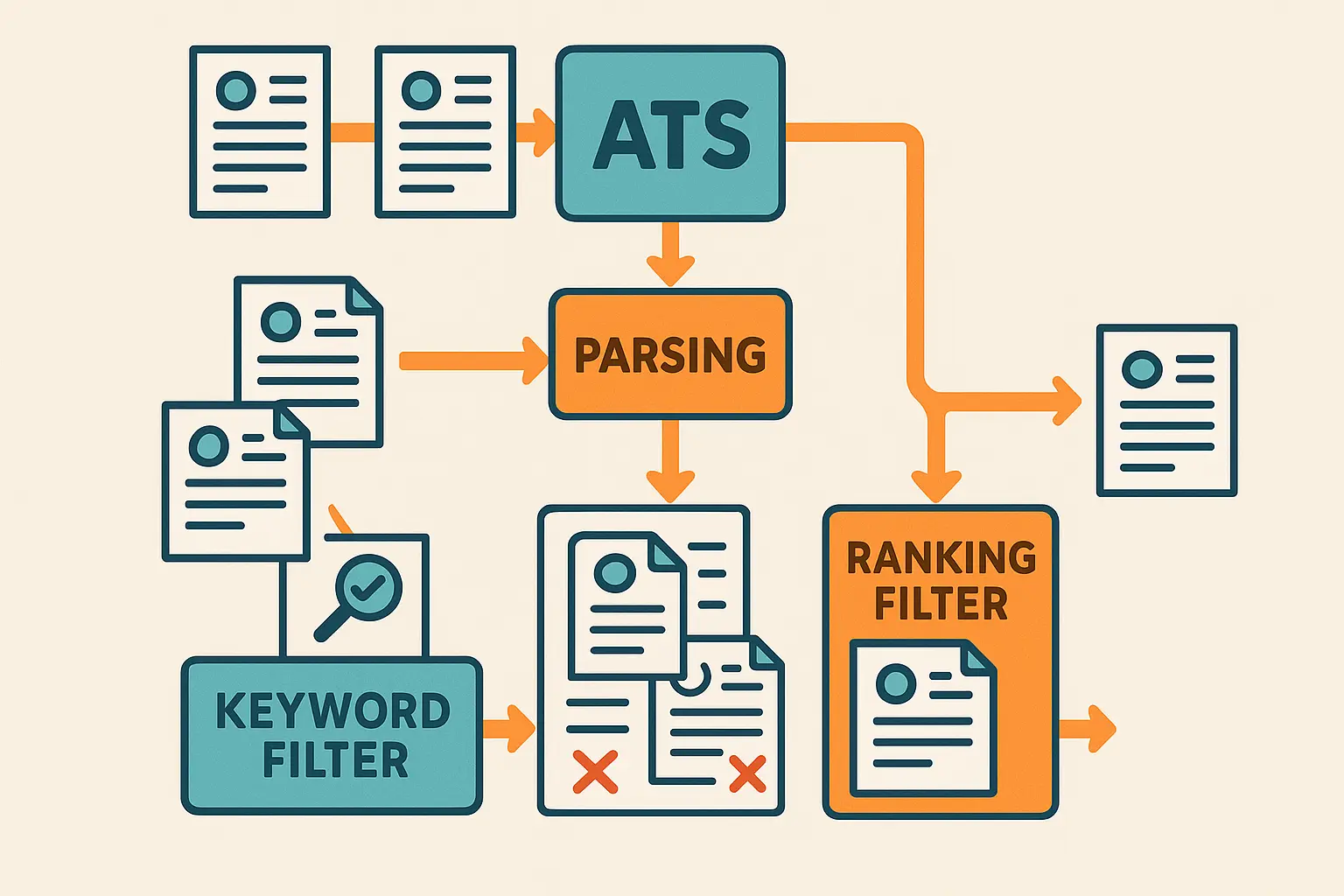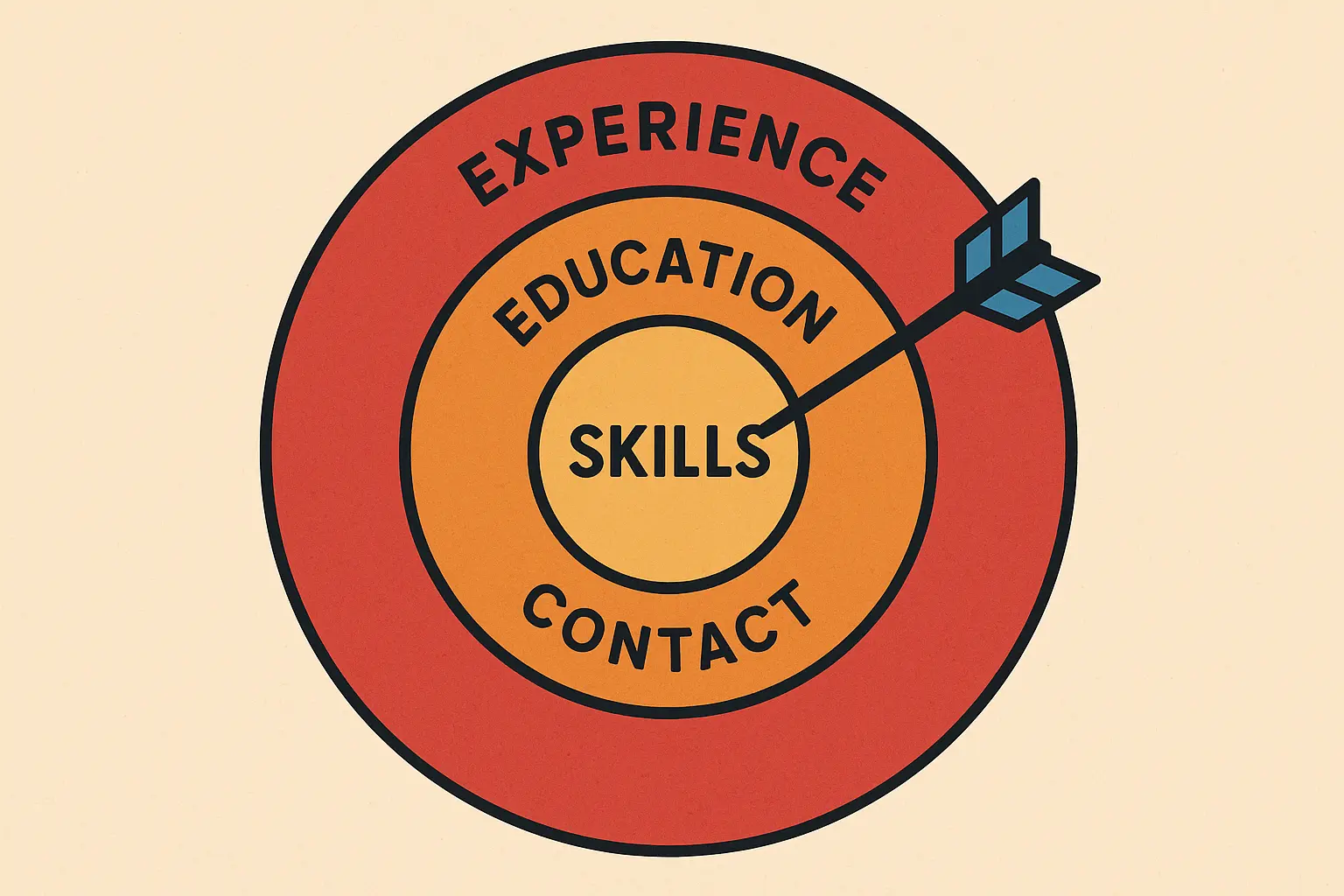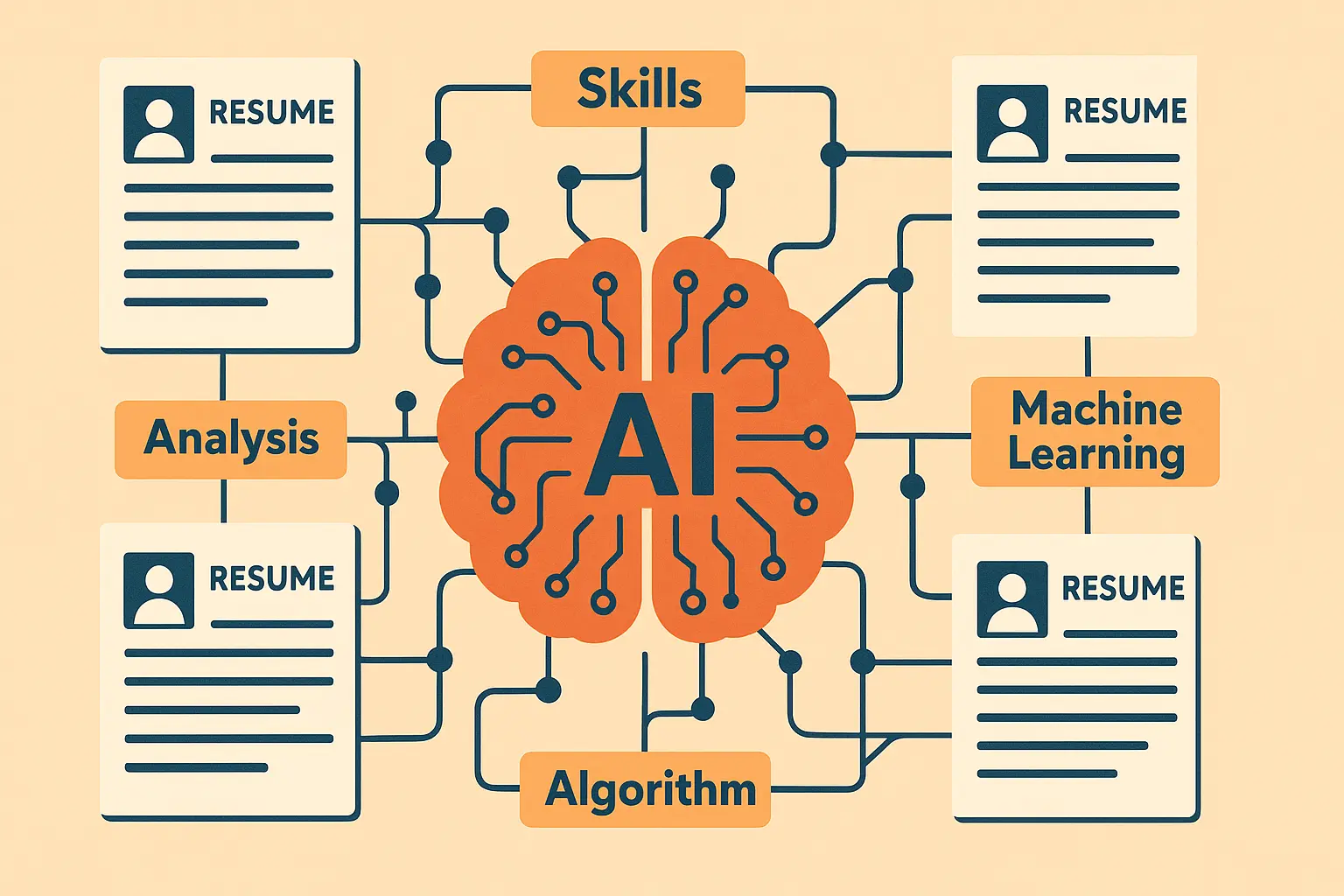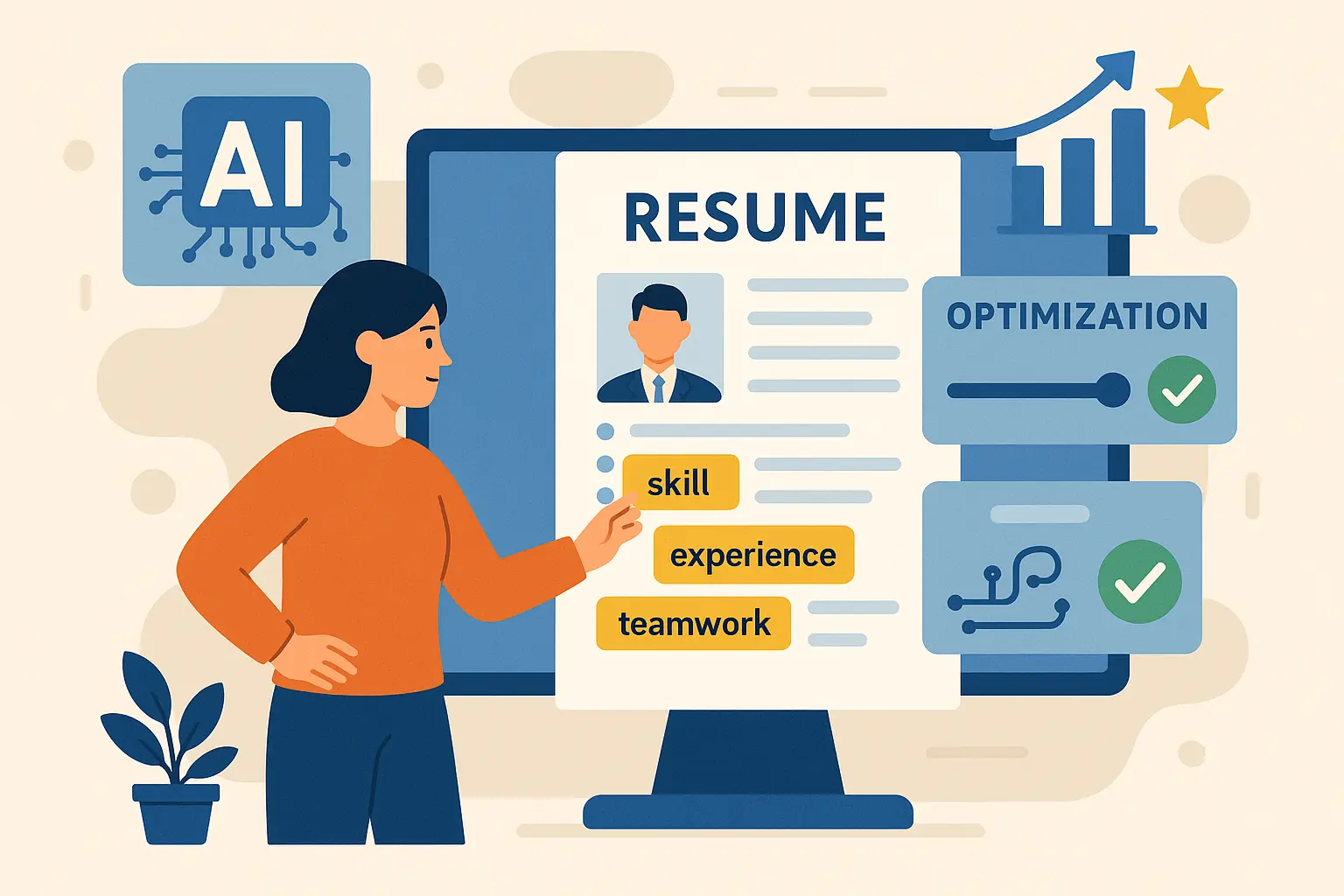Resume Keywords That Actually Get You Hired: The Real Story Behind What Works

Look, I’m going to be straight with you about resume keywords. Most advice out there is garbage. People tell you to “sprinkle in buzzwords” like you’re seasoning a salad, but that’s exactly how you end up in the rejection pile.
Here’s what actually happens: 75% of resumes get tossed by robots before a human ever sees them. But here’s the thing – once you understand how these systems think, you can beat them at their own game.
I’ve watched countless qualified people get rejected because they didn’t speak robot. Meanwhile, less qualified candidates who knew the keyword game sailed through to interviews. It’s frustrating, but it’s reality.
Table of Contents
-
The Truth About How Resume Keywords Really Work
-
Why Your Resume Gets Rejected Before Anyone Reads It
-
Finding the Right Keywords Without Going Crazy
-
Advanced Tricks That Actually Move the Needle
-
Final Thoughts
TL;DR
-
Your resume needs to speak two languages: robot and human
-
Over 90% of big companies use robots to filter resumes before humans see them
-
Certain spots on your resume matter way more than others for getting past the robots
-
Job postings are treasure maps – they tell you exactly what words to use
-
Modern systems are smart enough to catch related terms, but you still need the exact phrases
-
Keyword stuffing makes you sound like a broken robot and humans hate it
-
Industry-specific words signal you actually know what you’re doing
The Truth About How Resume Keywords Really Work
Here’s what nobody tells you: you’re not writing for one audience. You’re writing for picky robots first, then humans second. And these two audiences want completely different things.
The robots want specific words in specific places. They’re literal-minded and obsessive about exact matches. Humans want to see you’re a real person who can actually do the job, not just someone who memorized a dictionary.
“AI resume builders are churning out polished, keyword-optimized documents faster than you can say ‘results-driven professional,’ while AI applicant tracking systems are scanning through applications looking for specific patterns and phrases”. Everyone’s starting to sound the same, which means authenticity is your secret weapon.
I’ve seen people nail the robot test but bomb with humans because their resume read like a technical manual. I’ve also seen amazing candidates get rejected because they used “managed projects” instead of “project management” – literally one word difference, but the robot didn’t care about their qualifications.
Understanding the fundamentals of ATS-friendly resume formatting gives you the foundation to make both robots and humans happy.
What Resume Keywords Actually Are (And Why Everyone Gets This Wrong)
Most people think keywords are fancy words you throw around to sound smart. Wrong. They’re the professional vocabulary that proves you belong in your industry.
Think of it like this: if you walked into a construction site and started talking about “vertical support structures” instead of “walls,” everyone would know you don’t actually work in construction. Same thing with your resume.
|
Keyword Type |
What It Does |
Robot Priority |
Human Impact |
|---|---|---|---|
|
Hard Skills |
Proves you can do the work |
High |
Immediate credibility |
|
Soft Skills |
Shows how you work |
Medium |
Cultural fit signal |
|
Industry Terms |
Proves you speak the language |
High |
Insider knowledge |
|
Action Verbs |
Shows impact |
Medium |
Results focus |
|
Certifications |
Official proof of skills |
Very High |
Instant credibility |
Hard Skills vs. Soft Skills: What Actually Matters
Hard skills are the stuff you can measure and test. Python programming, Google Analytics, Salesforce administration – these are concrete capabilities that both robots and humans can verify.
Soft skills are trickier. They’re about how you work with people and approach problems. Leadership, problem-solving, collaboration – important, but harder to prove.
Here’s the thing: robots love hard skills because they’re specific and searchable. Humans care about both, but they want to see soft skills demonstrated through stories, not just listed.
The key difference between hard and soft skills becomes crucial when you’re trying to satisfy both robot screeners and human reviewers.
Hard Skills Reality Check: Instead of “good with computers,” say “Advanced Excel (pivot tables, VLOOKUP, macros)” or “Salesforce CRM administration with Lightning Experience.”
Soft Skills That Actually Work: Skip “team player” and try “Led cross-functional team of 8 engineers and marketers to deliver product launch 2 weeks ahead of schedule, resulting in 15% faster time-to-market.”
Industry Language That Makes You Sound Like You Belong
Every field has its secret handshake words. Tech people say “agile methodology” and “DevOps.” Healthcare workers talk about “patient care coordination” and “HIPAA compliance.” Marketing folks throw around “conversion optimization” and “customer journey mapping.”
Use the wrong words, and you immediately out yourself as an outsider. Use the right ones, and people assume you know what you’re talking about.
I can spot someone who’s never actually worked in their claimed industry within seconds. They use generic business speak instead of the specific terminology that insiders use without thinking.
Action Words That Show Results Instead of Just Duties
Power verbs paired with numbers tell a story. “Orchestrated,” “streamlined,” “optimized” – these words suggest you made things better, not just showed up.
The difference between “managed social media accounts” and “grew social media engagement by 45% through strategic content planning and community management” is massive. One sounds like a job duty, the other sounds like an achievement.
The Psychology Behind Why Certain Keywords Work
Here’s what’s really happening: hiring managers develop mental shortcuts. When they see specific words, they immediately categorize you as either “knows their stuff” or “probably doesn’t.”
88% of employers say their hiring systems filter out qualified candidates who don’t precisely match the job description. That should scare you into taking this seriously.
The psychology runs deeper than matching. Recruiters spend 6-7 seconds scanning your resume. In that time, they’re looking for familiar patterns and terminology that fit their mental checklist. Miss those signals, and you’re out.
How Recruiters Actually Scan Your Resume
I’ve watched hundreds of recruiters review resumes. Their eyes follow the same pattern every time: headline, skills section, first few bullet points under current job, education. If they don’t see what they’re looking for in those spots, they move on.
They’re not reading your beautiful prose. They’re pattern matching. Looking for keywords that match their requirements. It’s almost mechanical.
Common Mistakes That Kill Your Chances
The biggest mistake? Treating keywords like decoration instead of substance. I see people add impressive-sounding terms they don’t understand or can’t back up in an interview.
Why Keyword Stuffing Backfires Every Time
I once saw a resume that said: “Results-driven, detail-oriented, innovative leader with extensive experience in strategic planning, project management, team leadership, and cross-functional collaboration.”
That sentence says absolutely nothing while cramming in buzzwords. It sounds like a broken robot wrote it.
Modern systems are smart enough to spot this garbage, and humans definitely notice when you sound like you swallowed a business dictionary.
Generic Language vs. Specific Qualifications
“Experienced professional” tells me nothing. “Certified project management professional with 5 years in construction” tells me everything.
“Team player” is meaningless. “Bilingual customer service specialist fluent in Spanish and English” is specific and valuable.
Vague claims make you forgettable. Specific qualifications make you memorable.
Why Your Resume Gets Rejected Before Anyone Reads It
Think of ATS systems as really picky robots. They scan your resume looking for specific words and phrases. Miss the right terms? You’re out. But here’s the good news: these robots are predictable once you crack their code.
Over 90% of Fortune 500 companies use these digital gatekeepers. And “by the end of 2025, seven out of 10 companies of all sizes plan to use AI at some point during the hiring process”. This isn’t going away – it’s getting bigger.
The frustrating part? You might be perfectly qualified but get rejected because you said “managed projects” instead of “project management.” The robot doesn’t care about your skills – it only cares about exact word matches.
Learning how to use an ATS resume checker helps you catch these issues before you hit submit.
How ATS Systems Actually Work (It’s Not What You Think)
When you submit your resume, here’s what happens: The ATS immediately starts breaking down your document, pulling out information and stuffing it into database fields. It’s looking for your name, contact info, work history, skills, education – everything.
Then it starts scoring you based on how well your extracted information matches the job requirements. This isn’t a human reading your resume – it’s a computer program analyzing text patterns and assigning you a number.
What surprises people is how literal these systems are. If the job posting asks for “project management” and you only mention “managing projects,” some systems won’t make the connection. They’re smart, but not that smart.
The Technical Side: How Your Resume Gets Chopped Up
The ATS reads your resume like a scanner reads a barcode. Clean, simple formatting with standard fonts helps it understand what it’s looking at. Get fancy with your design, and the robot might think your name is your job title.
I’ve seen gorgeous resumes that looked like gibberish to the ATS. The system couldn’t figure out where one section ended and another began, so it just gave up and rejected the candidate.
Your ATS resume format needs to be robot-friendly first, pretty second.
Scoring Systems That Determine Your Fate
Here’s how most ATS systems prioritize your resume sections:
-
Skills section – This is prime real estate (30% of your score)
-
Work experience – Where you prove you’ve done the work (35% of your score)
-
Professional summary – Your elevator pitch (25% of your score)
-
Education – Usually just for specific requirements (10% of your score)
The scoring isn’t random. Systems weight different sections based on what hiring managers typically look at first. Your skills section gets premium treatment because that’s where recruiters expect to find your core qualifications.
Why Semantic Matching Changes the Game
Plot twist: modern ATS systems are getting smarter. They’re starting to recognize that “artificial intelligence,” “AI,” and “machine learning” are related concepts. This semantic matching means you don’t need every possible variation of a term.
But – and this is important – you should still include the most common versions. Don’t assume the system will make connections that seem obvious to you.
Where to Hide Your Keywords (So ATS Systems Actually Find Them)
Location matters more than frequency. You can stuff keywords everywhere, but if they’re not in the right spots, the robot won’t care.
Think of your resume like prime real estate. Some locations are penthouse suites, others are basement storage. You want your best keywords in the penthouse.
Skills Sections: Your ATS Sweet Spot
This is where robots look first and hardest. Include both the technical skills and soft skills from your target job postings, using the exact same terminology.
Create a master skills list from your research, then customize it for each application. If the job posting says “Google Analytics,” don’t put “web analytics.” If it says “project management,” don’t put “managing projects.”
Sneaky Tricks That Make Robots Love Your Resume
Advanced optimization isn’t about tricking the system – it’s about communicating effectively within its constraints. These techniques help you maximize robot performance while keeping humans happy.
Synonym Strategies That Multiply Your Matches
Include multiple versions of key terms to catch different ways employers might describe the same thing. “Artificial intelligence,” “AI,” and “machine learning” cover your bases without sounding repetitive.
The trick is natural integration. You want variety without making your resume sound like a thesaurus exploded.
Context That Proves You’re Not Just Keyword Stuffing
When you write “Implemented Salesforce CRM system, resulting in 40% improvement in lead tracking efficiency and $200K annual cost savings,” you’re doing three things:
-
Including the keyword “Salesforce CRM”
-
Providing context that proves you actually used it
-
Showing measurable results that humans love
This approach satisfies both robot requirements and human expectations.
Finding the Right Keywords Without Going Crazy
Effective keyword research is like detective work. You’re gathering clues about what employers actually want, then positioning yourself using their language.
The research phase feels tedious, but it’s where the magic happens. You’re reverse-engineering the hiring process to understand exactly what they’re looking for.
Job Postings: Your Keyword Treasure Map
I treat job postings like treasure maps. Every requirement, every “nice-to-have” skill, every piece of preferred experience represents a potential keyword opportunity. The companies have already done the work of defining what they want – you just need to decode their language.
Step-by-Step Job Description Mining
Here’s your homework: Collect 10-15 job postings for your target role. Print them out or open them in separate tabs. Get a highlighter.
Now systematically highlight every skill, qualification, and requirement. Look for patterns. What terms show up in 80% of the postings? Those are your must-haves. What appears in 40-50%? Those are your nice-to-haves.
Create a simple spreadsheet to track frequency. This removes guesswork and reveals patterns you’d miss with casual reading.
Real Example:
For a Digital Marketing Manager role, after analyzing 12 job postings, you might find:
-
Must-have (80%+ frequency): Google Analytics, SEO, PPC, content marketing, social media marketing
-
Nice-to-have (40-60% frequency): Marketing automation, A/B testing, conversion optimization
-
Emerging trends (20-40% frequency): AI marketing tools, programmatic advertising, customer journey mapping
Which Keywords Actually Matter
Focus your energy on terms that appear in 70% or more of your target postings. These are the non-negotiables. Keywords that show up less frequently might be nice differentiators, but don’t stress if you can’t include them all.
This frequency analysis prevents you from chasing every shiny keyword. Prioritize what matters most to the majority of employers in your space.
Industry Research That Goes Beyond Job Postings
Job postings only tell part of the story. Industry publications, professional associations, and thought leaders often discuss emerging trends before they become standard job requirements.
Professional Associations: The Official Dictionary
Industry organizations create the official vocabulary for your field. When the Project Management Institute defines specific methodologies or the American Marketing Association outlines core competencies, they’re establishing the language that serious professionals use.
These resources provide authoritative terminology that carries professional credibility.
LinkedIn Intelligence: Learning from Winners
Look at profiles of people who have jobs you want at companies you’re targeting. Pay attention to how they describe similar experiences to yours, what skills they emphasize, and what terminology they use consistently.
LinkedIn profiles show you how successful professionals position themselves in real-world language, not just corporate job posting speak.
Certification Programs: Standardized Vocabularies
Even if you don’t hold specific certifications, understanding their terminology helps you speak the language that certified professionals use. These programs create official vocabularies that become industry standards.
Your Keyword Research Action Plan:
-
Collect 10-15 relevant job postings
-
Highlight recurring terms and rank by frequency
-
Check industry association terminology
-
Study successful LinkedIn profiles in your field
-
Note certification vocabularies in your area
-
Create a master keyword list organized by priority
-
Test combinations for natural flow
Advanced Tricks That Actually Move the Needle
The difference between amateur and professional keyword optimization comes down to using the right tools and taking a systematic approach. Instead of guessing what works, you can get data-driven feedback that actually improves your results.
Technology has revolutionized this game in ways that weren’t possible even five years ago. You can now get instant analysis of your keyword coverage and specific recommendations for improvement.
Tools That Take the Guesswork Out of Keywords
These platforms eliminate the manual work and give you objective feedback on your optimization efforts. No more wondering if you’re on the right track.
Jobscan: Your Resume Report Card
Jobscan works like this: upload your resume, paste the job description, get a detailed analysis of what you’re missing. The platform shows you exactly which keywords to add and where they’ll have the most impact.
Here’s a stat that’ll blow your mind: “candidates who include the job title on their resume are 10.6 times more likely to get an interview”. That’s the kind of specific, actionable insight these tools provide.
What I love about Jobscan is its specificity. Instead of vague advice about “more keywords,” it tells you exactly which terms you’re missing and how to fix it. The scoring system gives you objective feedback that removes emotion from the process.
You can scan, optimize, re-scan, and track your improvement across different applications. It creates a feedback loop that continuously makes your resume better.
Other Tools Worth Checking Out
Resume Worded focuses on writing quality and gives detailed suggestions for improving your bullet points. VMock offers comprehensive analysis including visual design feedback. SkillSyncer specializes in skills gap analysis.
The key is finding tools that give you actionable insights without overwhelming you with information. Some people want detailed technical analysis, others prefer simple recommendations they can implement quickly.
AI-Powered Resume Enhancement
AI writing tools have gotten scary good at understanding context and professional communication standards. They can help you find the sweet spot between keyword optimization and natural language.
Natural Language Processing for Better Writing
AI assistants can transform basic job descriptions into compelling, keyword-rich bullet points that sound natural while hitting all the algorithmic requirements.
For example, AI might take “managed social media accounts” and suggest “Orchestrated comprehensive social media marketing campaigns across Instagram, LinkedIn, and Twitter, driving 45% increase in brand engagement and generating 200+ qualified leads monthly through strategic content optimization.”
Same basic idea, but now it’s packed with relevant keywords and measurable results.
Automated Keyword Suggestions Based on Real Data
Machine learning algorithms analyze massive datasets of successful job applications to recommend keywords specific to your industry and experience level. They identify patterns that individual job seekers would never catch.
These systems have access to hiring data across thousands of companies, allowing them to suggest terminology and phrasing that actually works in practice.
How Resume Builder IQ Solves Your Keyword Headaches
Full disclosure: I work on Resume Builder IQ, which handles a lot of this keyword optimization automatically. But even if you never use our platform, the strategies in this guide will help.
Resume Builder IQ addresses the main pain points by providing AI-powered keyword optimization that eliminates guesswork. The platform analyzes job descriptions and suggests relevant terms while you build, offering real-time optimization that increases ATS compatibility without sacrificing readability.
The 25+ ATS-friendly templates ensure proper keyword placement and formatting, while integrated AI writing features transform basic prompts into compelling, keyword-rich content. With proven results showing 38% more interviews and 23% higher job offer rates, the platform provides sophisticated keyword analysis that would cost hundreds with a career coach.
Whether you’re targeting specific industries, changing careers, or optimizing for multiple roles, Resume Builder IQ ensures your resume speaks the language employers and ATS systems want to hear.
When selecting the best resume builders for keyword optimization, look for platforms that offer integrated ATS analysis and real-time feedback.
Your Advanced Optimization Checklist:
-
Run your resume through ATS scanning tools
-
Test different keyword densities and placements
-
Use AI writing assistants for natural integration
-
Verify formatting works across different platforms
-
Track application response rates by keyword strategy
-
A/B test different resume versions
-
Monitor industry keyword trends quarterly
-
Update keywords based on actual performance data
Final Thoughts
Here’s the bottom line: keywords aren’t about tricking anyone. They’re about speaking the same language as the people who want to hire you.
The job market has evolved, and your approach needs to evolve with it. The days of sending out generic resumes and hoping for the best are over. Today’s successful job seekers understand that getting noticed requires strategic communication that works for both robots and humans.
What strikes me most about this whole landscape is that it’s really just about clarity and relevance. When you use the right terminology, you’re making it easier for the right opportunities to find you.
The tools and strategies I’ve outlined here aren’t magic bullets, but they are proven methods that can significantly improve your chances of getting noticed. The key is implementing them thoughtfully, maintaining authenticity while optimizing for modern recruitment realities.
Start with one job posting today. Highlight every skill and requirement. Then look at your resume and see how many you’re missing. That’s your homework.
Remember that effective keyword optimization works hand-in-hand with professional resume formatting to create documents that perform well with both ATS systems and human reviewers. The combination of strategic keywords, proper formatting, and compelling content creates the foundation for job search success in today’s competitive market.
Your future self will thank you when the interview requests start rolling in.

